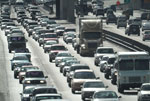Perhaps the increased traffic jam time is not surprising, considering the economy improved in the San Francisco-Oakland Area from 2010 to 2011.
“When the economy recovers, so does traffic congestion and when unemployment lines shrank, lines of bumper-to-bumper traffic grew,” the researchers wrote.
But if traffic is a measure of the San Francisco-Oakland area's vitality, it’s still not as vigorous as in 2005 when commuters wasted an average of 89 hours stuck in traffic. (The figure for San Jose was 40 hours.)
The average San Francisco-Oakland driver burned an extra 25 gallons of gas and and lost $1,266 because of traffic snarls, the researchers found.
The researchers calculated that traveling during rush hour takes 1.22 times longer than the same trip would take without traffic, meaning that a 20-minute zip from Oakland to San Francisco averages 25 minutes.
That doesn’t sound bad at all, but as we all know, conditions can vary widely. If you want to make sure you’re only late for work once a month, you have to allow 3.74 times as long to get there as the trip would take on uncongested freeways. So for a 20-minute drive, you have to allow an hour and 15 minutes.
If you can be late as often as once a week without getting fired, then you only have to allow twice as much time as the trip would take in ideal conditions -- or 40 minutes for that 20-minute trip.
If the San Francisco-Oakland area ranks high in traffic jams, it’s also near the top in efforts to fix the problem. It’s number 3 in systems intended to improve traffic flows, including synchronized traffic signals on some major roads, freeway ramp metering and carpool lanes. These road systems save the area’s commuters a total of 18,956 hours and $400 million a year, the researchers calculated.
And the area came in No. 4 for public transportation. Its buses, streetcars, trains and ferries save commuters 36,714 hours and $776 million a year, they said.
